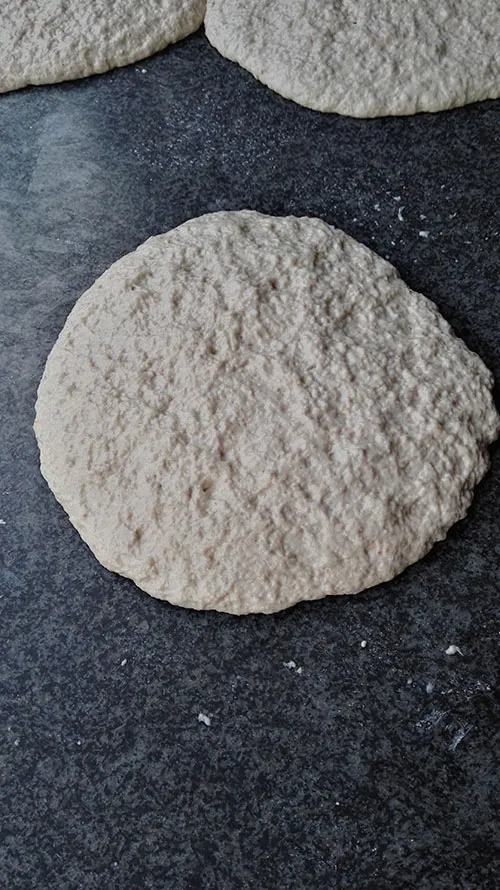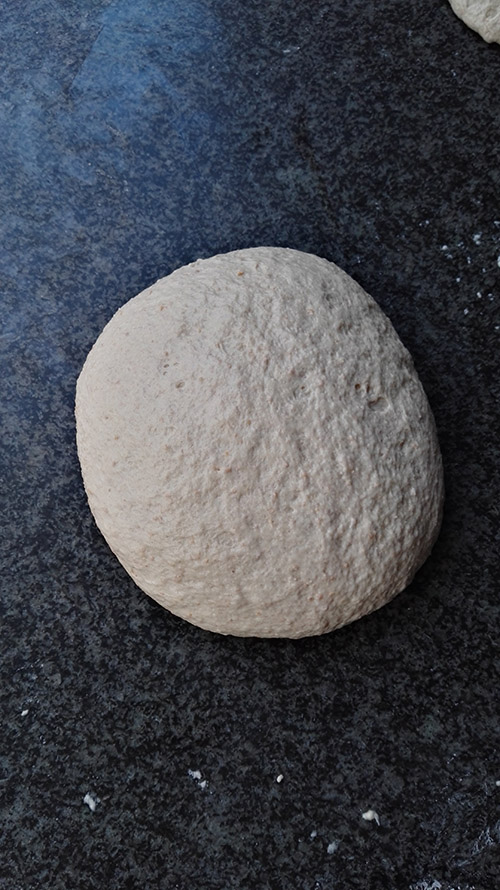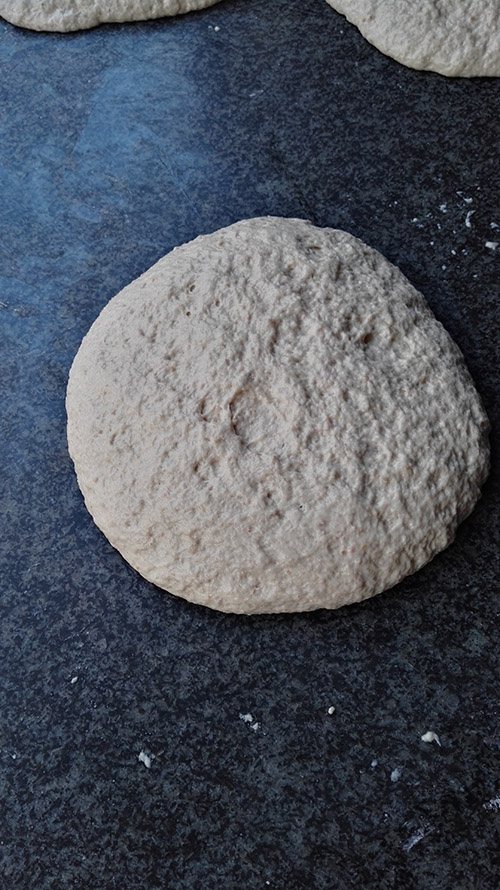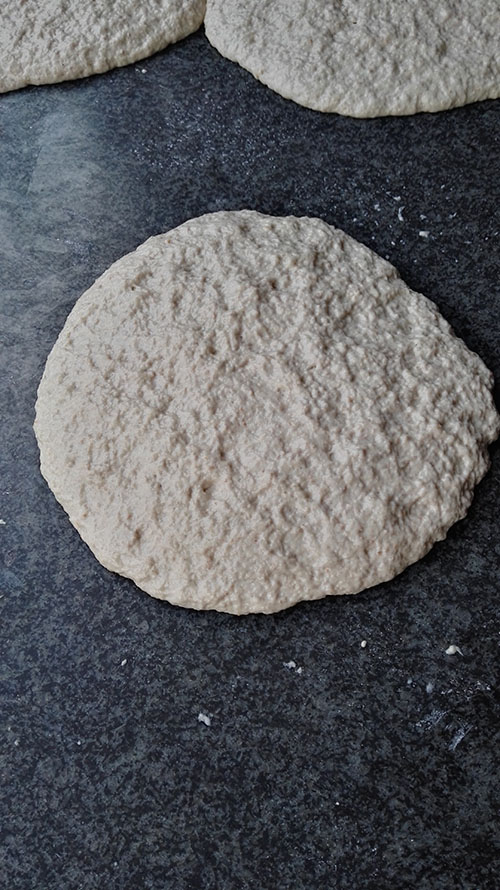
I'm baking sourdough bread for a couple of years now. Most of the time with succes.
But sometimes, without warning, something strange happens with my dough.
I start noticing it during bulk fermentation. Were I had a nice gluten development after autolyse and during the first 3-4 folds, the dough starts to tear more and more.
After bulk, when I try to shape the loaf, It completely falls apart. There is no surface tension and the dough becomes instantly a slack mess. It ends into the bin.
Below a couple of pictures of the 'falling apart' moment. And a gif so you can see the speed of it.
Where do I fail?
The dough is 63% hydration, with strong flour (12%), sourdough starter is 100%
(complete recipe: 436 gr flour, 24 gr whole, 290gr water, 10 gr salt, 50 gr starter)




...finished folding? It might give you a clearer idea of how developed the gluten is. Also, without changing the formula, it's sometimes a good idea to vary the techniques you use. This helps identify what the issue is; for example, is it one of technique or ingredient? When I've had similar problems, I've tried hand-kneading (or machine-kneading) instead of stretch-and-fold. If that produced a good loaf, I knew immediately where the error was. If not, I then moved on to other factors like bulk fermentation, ingredients, starter activity etc.
See if this link helps: http://www.thefreshloaf.com/comment/121566#comment-121566
Paul
good call and a great link...stories like this sometimes keep me up at night as I start my bakery, and arming myself with this kind of info helps a great deal, if only for piece of mind (I knew about thiols, including the release of glutathione from dead yeast, but the thiol producing bacteria in a starter was a new one for me)...
What I see in these photos is excessive proteolysis. The surface is broken and falling apart, and you can't bring it back together (as opposed to thiol interference which is smooth, but stretchy and flabby). Excessive proteolysis is a perfect storm of 3 factors converging in your dough.
1) proteolytic enzymes - whole wheat flours bring a lot, but white flours have a little too
2) acidity - proteolytic enzymes become more active as the pH drops
3) time - it takes time for enzymes to do their work
Your starter increases the acidity and time if it is sluggish or overly acidic. So does stretching out fermentation time too long. More is not necessarily better, especially with whole wheat in the mix. Reevaluate your starter maintenance routine, shorten fermentation times if need be, and if those don't solve the problem, try a different flour.
Interesting! Had a experience like this last year: I maintained a rye starter only which worked very well for the different breads a made. 70% rye bread and a sandwich bread with about 10% rye and 90% AP. Then I wanted to make a 100% AP (white) sandwich bread. I did like always, started with little bit rye, fed AP twiceTo get the needed amount of starter. I did not notice a problem there. But then my dough did not really rise well, got kind of sloppy. I tried to shape it and put it in the bannetons.......not further rise at all. It just sat there like dead.
i tried three times, adjusted hydration, folding, temp and forgot what else without any success. Finally I worked on my starter: little bit of rye starter, feeding it twice a day with AP over I think 3 or 4 days. It became very active and my bread turned out fine.
lesson learned: I am maintaining a rye starter and a wheat starter. Both are working very well. Do. still not know why always sudden my rye starter did not like AP anymore with the consequent failiour of the dough.
Barbara
l
Hello all,
Many thanks for the reactions.
At first my suspicion also went to the Thiol-devil. But since I made (with the same starter) perfect croissants at the same time, it was not realy an option.
The remarks of Debra made me thinking. And after all it makes perfect sense.
What I did wrong is basicly this: I had too much time that day I made the disaster loafs.
That day I decided to do things good, so I mixed the dough until I had some good window pane, than I placed the dough into a bucket. I kept it at 25°C, folding it every hour. This for about 5 hours...
There you have it. I overdevelopped the gluten to a point there was no turning back.
Most day's I mix the douch very brief, than it can hold a couple of hours in the proofingchamber. Or I mix it hard for leaving the dough cool.
Now I did the best of two worlds and that's not a good idea.
I did yesterday the test, good mixing and bulkrise of 2 hours.
Below you can see the result. Mistery solved!
while this mystery is solved, I wanted to add to the list of possibilities that might explain dough that goes limp after what seems like an initially good start (besides thiols and overmixing), just for reference/general learning...
rereading my Hammelman, he has a little side bar on starch damage, stating that above 10% damaged starch, one notices a number of characteristics in bread dough (p. 35):
- high absorption
- dough becomes slack after mix
- dough becomes more slack and sticky during bulk
- shaped loaves flatten out
- poor spring and opening of cuts
- excess color
- crust softens after baking
(he also mentions the dough weeping, or giving off some water)
cheers!
seriously .
I tested it when I got my first dough hook mixer . It runs on a 6 min cycle .
6 mins , pretty good , 12 mins , yep just right , 18 mins , broke and fell off the hook right before my eyes before the cycle finished.
No gluten strands to speak of , all torn to shreds .
lol
...now, if we only had pictures to illustrate and compare examples of each explanation...hmmm...
but I didn't have a camera back then , still don't